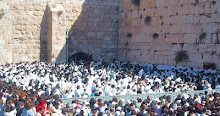http://www.independent.co.uk/news/world/europe/can-the-pope-solve-riddle-of-the-last-supper-1682663.html
Can the Pope solve riddle of the Last Supper?
Vatican's designs on building annoy Israel
By Ben Lynfield in jerusalem
Monday, 11 May 2009
It is said by the Vatican to be the site of a seminal moment in human and divine history, when Jesus shared his last meal with his 12 Apostles, instituted the Eucharist and revealed that one of the Apostles would betray him. Today it requires a good deal of imagination – or faith – to place the Last Supper inside the chilly room with Gothic arches in a building that dates from 13 centuries after the death of Jesus.
Still, the Vatican claims the room as the second holiest site in Christianity, after the Church of the Holy Sepulchre where Jesus is believed to have been buried. And in an ironic twist, the Last Supper room has become the flashpoint of festering disputes between Israel and the Catholic Church that threaten to impinge on Pope Benedict XVI's first pilgrimage to the Holy Land,. which starts today.
Vatican officials had hoped the run-up to the pontiff's visit would soften Israel's position over the Last Supper room, on Mount Zion, just outside the walls of the Old City of Jerusalem. The claimed site of King David's Tomb, revered by some Jews (?!, DS), is just below it and a minaret rises above it bearing witness to the room's four centuries as a mosque, which ended in 1948.
The second-floor location is crucial to the sense of the room being sacred. Tradition holds that the Last Supper took place in an upper chamber, something that inspired the Franciscans who controlled the building from 1335 to 1523 to associate Jesus's last meal with his Disciples with the room. However, the Ottoman Turkish rulers of Jerusalem expelled the Franciscans and converted the room into a mosque, charging that the Catholics were detracting from the sanctity of the tomb of David, also revered in Islam.
Despite Vatican requests, including in advance of the Pope's visit to the room tomorrow, Israel remains reluctant to hand it over.
Israel's approach seems more pragmatic than sentimental. The Tourism Minister, Stas Misezhnikov, who heads an inter-ministerial committee for the Pope's visit, said it would be a mistake to hand over the Last Supper site to the Vatican without a significant reward. He is hoping for assistance from the Vatican in bringing millions of Catholic tourists to Israel but first apparently requires clear signs that the Vatican is on board.
"If we were certain that this great gift to the Christian world would bring us millions of Christian tourists we might think about it. But since that isn't going to happen, we have no reason to give away presents," Mr Misezhnikov told Army Radio. In subsequent remarks, Mr Misezhnikov softened his tone, saying he was studying the issue.
The matter is highly emotional for the Vatican. The papal nuncio in Jerusalem, Monsignor Antonio Franco, made clear this week that the Last Supper room is crucial for the Church: "Our home was there and I want to be at home," Monsignor Franco said.
When he comes to pray, the Pope will find himself inside a structure that still looks very much like a mosque. "In the name of Allah, the merciful, the compassionate," reads a wall inscription in Arabic. The prayer niche, which blocks out a window, is in Moorish style and marble pillars hold up a pulpit that has a white and black striped arch similar to what one sees in old mosques in Cairo. It is a far cry from the flat-ceilinged room with the long table depicted in Da Vinci's The Last Supper.
But the Church's memory is long. "The Eucharist, the unity of the Church, the Pentecost and the priesthood; all these important things for the Latin Church come from here. It seems like a very modest place but it would have a very strong impact on the lives and mentality of all the Catholics all over the world because the Church was founded here, our life was founded here," said the Vatican's Custodian for the Holy Land, Father Pierbattista Pizzaballa.
As if to underscore his words, a group of German Catholics broke into a 200-year-old hymn about the Last Supper as they toured the room yesterday. "He took the bread and wine and thanked God," they sang. "He told them to take it and to drink it and to eat it. This is my body and my blood. Never forget what my love is doing for you."









No comments:
Post a Comment